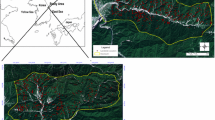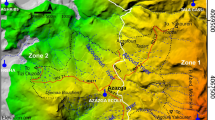Abstract
This study is aimed at developing a method for modelling the probability of landsliding using a geographical information system (GIS), rainstorm events and associated landslide distributions, with an attempt to assess where landslides are likely to occur when certain rainstorm events happen. This research focuses on the natural terrain of Lantau Island, Hong Kong. In order to derive a logistic regression model for statistical prediction of the probability of landsliding, topographic attributes derived from digital elevation model (DEM) data are combined with a variety of other digital datasets including 24 h rainfall, lithology and vegetation cover in a GIS. The model was then applied to given rainstorm events and rainfalls of a variety of periods of return time in order to predict the probability of landsliding on natural slopes in space and time. The modelling techniques described here can be used to develop effective mitigation strategies.
Résumé
Cette étude a pour but le développement d’une méthode de modélisation de la probabilité de déclenchement de glissements de terrain, en utilisant un système d’information géographique (SIG), les répartitions des pluies torrentielles et les glissements associés. Elle comporte une tentative de prédiction de la localisation du déclenchement des glissements en fonction d’événements de pluies torrentielles. Cette recherche concerne l’île de Lantau, à Hong Kong. Les attributs topographiques issus des données d’un modèle numérique de terrain (MNT) sont associés à d’autres séries de données, dont la pluie journalière, la lithologie et la végétation, dans un système d’information géographique, afin de réaliser un modèle de régression statistique pour la prédiction du déclenchement des glissements de terrain. Ce modèle a été alors appliqué à des pluies torrentielles et des pluies de différentes périodes de retour, pour prévoir la probabilité de déclenchement de glissements de terrain sur des pentes naturelles dans l’espace et le temps. Les techniques de modélisation décrites peuvent être utilisées pour développer des stratégies concrètes de prévention.







Similar content being viewed by others
References
Atkinson PM, Massari R (1998) Generalized linear modelling of landslide susceptibility in the Central Apennines, Italy. Comput Geosci 24:373–385
Beven KF, Kirkby MJ (1979) A physically based, variable contributing area model of basin hydrology. Hydrol Sci Bull 24: 43–69
Brand EW, Premchitt J, Phillipson HB (1984) Relationship between rainfall and landslides. In: Proc 4th Int Symp on Landslides, 1984, Toronto, pp 377–384
Brunori F, Casagli N, Fischi S, Garzonio CA, Moretti S (1996) Landslide hazard mapping in Tuscany, Italy: an example of automatic evaluation. In: Slaymaker O (ed) Geomorphologic hazards. Wiley, Chichester, pp 55–67
Carrara A, Cardinali M, Detti R, Guzzetti F, Pasqui V, Reichenbach P (1991) GIS techniques and statistical models in evaluating landslide hazard. Earth Surf Process Landforms 16:427–445
Chung CF, Fabbri AG (1999) Probabilistic prediction model for landslide hazard mapping. Photogramm Eng Remote Sens 65:1389–1399
Cruden DM, Varnes DJ (1996) Landslide types and processes. In: Schuster RL, Turner AK (eds) Landslides, investigation and mitigation. Transportation Research Board Special Report 247, National Academy Press, Washington, DC, pp 36–75
Dai FC, Lee CF, Sijing W (1999) Analysis of rainstorm-induced slide-debris flows on natural terrain of Lantau Island, Hong Kong. Eng Geol 51:279–290
Dai FC, Lee CF (2001) Frequency-volume relation and prediction of rainfall-induced landslides. Eng Geol 59:253–266
Dai FC, Lee CF (2002) Landslide characteristics and slope instability modelling using GIS, Lantau Island, Hong Kong. Geomorphol 42:213–228
Dhakal AS, Amada T, Aniya M (2000) Landslide hazard mapping and its evaluation using GIS: an investigation of sampling schemes for a grid-cell based quantitative method. Photogramm Eng Remote Sens 66:981–989
Evans NC, Huang SW, King JP (1997) The natural terrain landslide study: phases I and II. Special Project Report SPR 5/97, Geotechnical Engineering Office, Hong Kong.
Florinsky IV, Kuryakova GA (2000) Determination of grid size for digital terrain modelling in landscape investigations: exemplified by soil moisture distribution at a micro-scale. Int J Geograph Inform Sci 14:815–832
Franks CAM (1996) Study of rainfall induced landslides on natural slopes in the vicinity of Tung Chung New Town, Lantau Island. Special Project Report SPR 4/96, Geotechnical Engineering Office, Hong Kong
Gupta RP, Joshi BC (1989) Landslide hazard zoning using the GIS approach: a case study from the Ramganga catchment, Himalayas. Eng Geol 28:119–131
Guzzetti F, Carrara A, Cardinali M, Reichenbach P (1999) Landslide hazard evaluation: a review of current techniques and their application in a multi-scale study, central Italy. Geomorphol 31:181–216
Hosmer DW Jr, Lemeshow S (1989) Applied logistic regression. Wiley, New York
Lam CC, Leung YK (1994) Extreme rainfall statistics and design rainstorm profiles at selected locations in Hong Kong. Technical Note no. 70, Royal Observatory of Hong Kong, Hong Kong
Langford RL, James JWC, Shaw R, Campbell SDG, Kirk PA, Sewell RJ (1995) Geology of Lantau District. Hong Kong Geological Survey Memoir no. 6, Geotechnical Engineering Office, Hong Kong
Lumb P (1965) The residual soils of Hong Kong. Geotech 15:180–194
Mark RK, Ellen SD (1995) Statistical and simulation models for mapping debris flow hazard. In: Carrara A, Guzzetti F (eds) Geographical information systems in assessing natural hazards. Kluwer, Dordrecht, pp 93–106
Montgomery DR, Dietrich WE (1994) A physically based model for the topographic control on shallow landsliding. Water Resour Res 30:1153–1171
Ng KC, Parry S, King JP, Franks CAM, Shaw R (2002) Guidelines for natural terrain hazard studies. Special Project Report SPR1/2002, Geotechnical Engineering Office, Hong Kong
Okimura T, Kawatani T (1987) Mapping of the potential surface-failure sites on granite slopes. In: Gardner E (ed) International geomorphology. Wiley Chichester, pp 121–138
Pun WK, Wong ACW, Pang PLR (1999) Review of landslip warning criteria. Special Project Report SPR 4/99, Geotechnical Engineering Office, Hong Kong
SPSS (1997) SPSS advanced statistics 7.5. SPSS, Chicago, 578 pp
Tang MC (1993) Report on the rainstorm of May 1982. GEO Report no. 25, Geotechnical Engineering Office, Civil Engineering Department Hong Kong
Varnes DJ (1984) Landslide hazard zonation: a review of principles and practice. Natural Hazards no. 3, UNESCO, Paris
Wong HN, Lam KC, Ho KKS (1998) Diagnostic report on the November 1993 natural terrain landslides on Lantau Island. GEO Report no. 69, Geotechnical Engineering Office, Hong Kong
Wu W, Sidle RC (1995) A distributed slope stability model for steep forested basins. Water Resour Res 31:2097–2110
Acknowledgements
Funding for this research was provided by the Research Grants Council of Hong Kong and the Chinese Academy of Sciences. The authors wish to express their sincere appreciation for the generous support.
Author information
Authors and Affiliations
Corresponding author
Rights and permissions
About this article
Cite this article
Dai, F.C., Lee, C.F., Tham, L.G. et al. Logistic regression modelling of storm-induced shallow landsliding in time and space on natural terrain of Lantau Island, Hong Kong. Bull Eng Geol Environ 63, 315–327 (2004). https://doi.org/10.1007/s10064-004-0245-6
Received:
Accepted:
Published:
Issue Date:
DOI: https://doi.org/10.1007/s10064-004-0245-6




